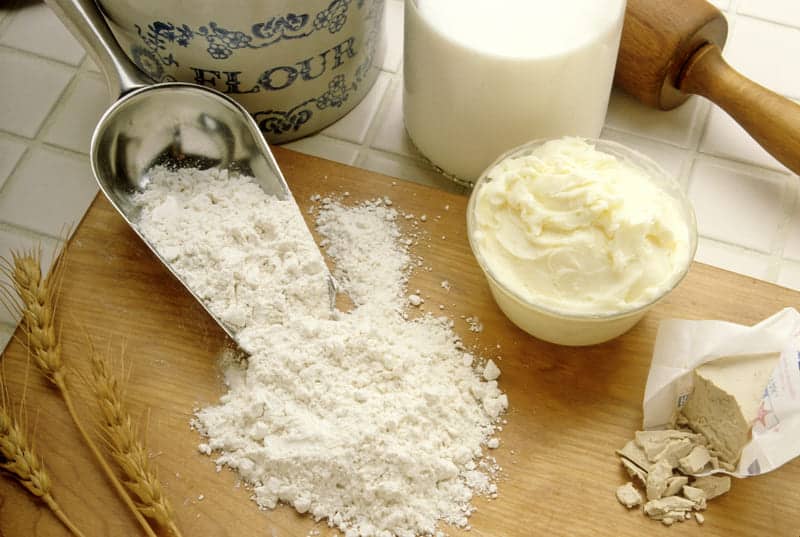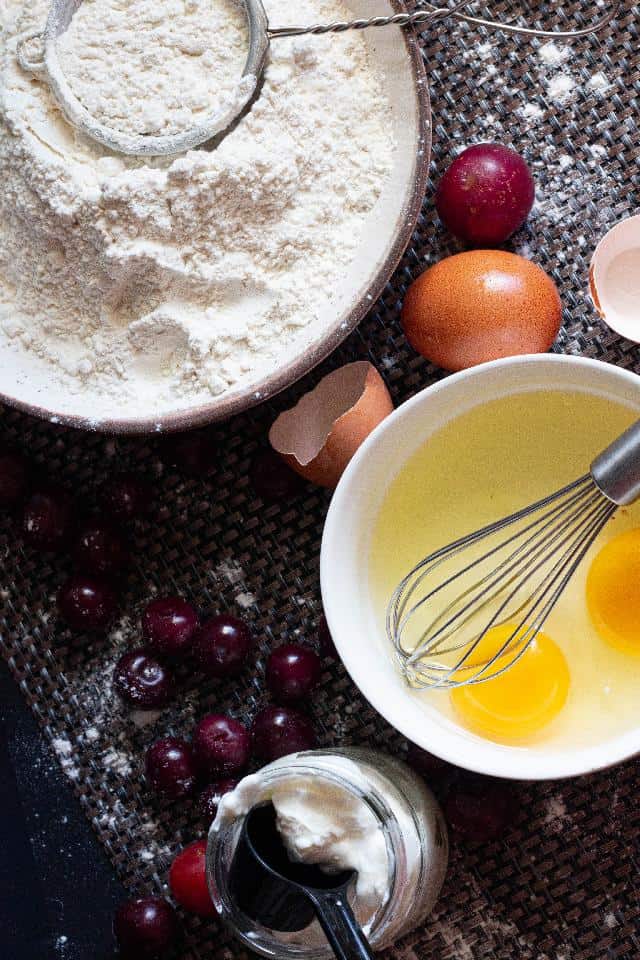Wondra flour is instant flour that dissolves instantly in liquids allowing you to make different recipes like sauce, crepes, gravy, stew, and pie crust, or as a dredging flour for poultry, meat, vegetables, and fish.
Let’s learn more about this popular flour and what can you use instead of Wondra flour when you don’t have it at hand.
What Is Wondra Flour?
Wondra flour is low-protein instant flour made of wheat flour and malted barley flour, vitamins, and minerals. It is heated and dried in a process known as pre-gelatinization, and finely milled. Therefore, Wondra flour dissolves well in liquids without creating lumps.
Wondra flour is used for breading and thickening stews, sauces, gravies, and soups. You can use it in baked goods as well. However, if your recipe calls for this flour and you don’t have it in your kitchen, you can use other things instead and yield the same results.
Substitutes for Wondra flour include rice flour, cassava flour, tapioca flour, cornstarch and all-purpose flour, whole wheat flour, roux, or some of the following products.
Let’s learn more about each substitute for Wondra flour below!
Best Wondra Flour Substitutes
Wondra flour is a versatile instant flour you can use in your recipes. However, you can also use some other type of flour instead of Wondra to prepare your favorite recipes.
1. Rice Flour
Rice flour consists of ground brown or white rice. You can use it in baked goods, as a substitute for wheat flour, as a thickener, and as breading for fried foods.
Rice flour is gluten-free and low in protein flour. You can use one tablespoon of rice flour as a substitute for ½ tablespoon of Wondra flour in your recipes.
2. Cassava Flour
Cassava flour consists of peeled, dried, and ground cassava roots.
It has a mild flavor and is usually used for breading, as a thickener in soups, gravies, and sauces, in cakes, cookies, and other baked goods, and as a coating for meats and vegetables.
Cassava flour is low in protein and gluten-free, therefore, it makes a good alternative for people allergic to gluten. Keep in mind that you have to use less cassava flour as a substitute for Wondra flour because it absorbs more liquids.
Substitute one cup of Wondra flour with 2/3 of a cup cassava flour and add more if needed.
3. Tapioca Flour
Tapioca flour is also made from cassava root. However, it is processed differently. It is gluten-free, has a fine texture, and doesn’t have any specific flavor.
Tapioca flour, also known as tapioca starch, can thicken sauces, gravies, soups, stews, and pie fillings. However, you can also use it in baked goods alongside other gluten-free flours and to make coating for meat and fish.
If you are using tapioca flour as a thickener, it is important to make a slurry by mixing the same amounts of tapioca flour with cold water. Then, stir and add the slurry to the hot liquid and mix to combine. If you add tapioca flour directly to hot liquids it will clump.
You can use tapioca flour as a substitute for Wondra flour in a 1:1 ratio.
4. Cornstarch And All-Purpose Flour
You can mix one cup of all-purpose flour with 1/2 teaspoon of cornstarch and use it as a substitute for Wondra flour in a 1:1 ratio.
You can use this combination as a thickener, in baked goods and for breading meats, fish, and other food. When you are using this mixture as a thickener it is important to make a slurry first then add it to the dish you are making.
Bring it to a boil for about 1 minute, reduce the heat and stir until the cornstarch is activated so you can get the desired texture. Cornstarch will also make your baked goods more tender and crumbly because it is very low in protein (100 gr contains only 0,3 gr) and gluten-free.
5. Whole Wheat Flour
Whole wheat flour is higher in protein than Wondra flour but you can use it as its substitute as a thickener. You can also use it for bread but you will get a tougher and chewy final product.
For better results mix one cup of whole wheat flour with ½ teaspoon of cornstarch and use it in your recipes. You can use it as a breading, make a slurry or roux and substitute this mixture with Wondra flour in a 1:1 ratio.
6. Roux
Roux is nothing but fat and flour mixed to create a mixture that will thicken up sauces, soups, gravies, and stews.
If you want to make roux you will need equal amounts by weight of oil or butter and flour. Add the flour to the melted butter or heated oil and cook until you get the desired color.
Roux can have a white, blond, or brown color and they are all used in different sauces, soups, gravies, and stews. Brown roux has less thickening abilities than the other two types of roux.
Depending on your recipe you can use any type of roux as a substitute for Wondra flour as a thickener.
7. Potato Starch
Potato starch is extracted from potatoes. It is clear white with a neutral flavor. It is also gluten-free and used in various recipes as a thickener, coating for fried foods, and as an alternative to flour in baking.
You can use potato starch instead of Wondra flour in your sauces, stews, soups, gravies, pie fillings, baked goods, and as a coating for meats, fish, and vegetables in a 1:1 ratio.
8. Cake Flour
Cake flour has a lower protein content than all-purpose flour, therefore, the baked goods and pastry have a softer, lighter, and fluffier texture than the ones made with all-purpose flour.
This flour works well for cakes, muffins, pancakes, cupcakes, pastries, desserts, and quick bread. If you don’t have any other flour on hand you can use cake flour as a substitute for Wondra flour in your recipes in a 1:1 ratio.
9. Pastry Flour
Pastry flour is also lower in protein than all-purpose flour and is usually used to make cookies, muffins, pies, biscuits, and pastry.
It is made of soft wheat and contains 8-10 % protein which means that your baked goods or pastry will have a light soft texture. You can use pastry flour as a substitute for Wondra flour in a 1:1 ratio.
10. All-Purpose Flour
All-purpose flour is a common flour for making cookies, cakes, pizza, pancakes, pie crusts, and crusty bread. You can also use it as a thickening agent in stews, soups, sauces, and gravy, and for coating meats, fish and vegetables.
All-purpose flour is usually a mix of soft and hard flour and has a protein content of 10-12%. Mix 2 cups of all-purpose flour and 1 teaspoon of cornstarch and sift the mix twice to make it more light and airy. Use this mix as a substitute for Wondra flour in a 1:1 ratio.
Wondra Flour Substitute For Frying
Wondra flour works well as a coating for fried meats, fish, and veggies because it makes crispy crusts.
However, if you don’t have Wondra flour on hand, you can use some of the substitutes mentioned in this article like rice flour, potato starch, corn starch, all-purpose flour, tapioca flour, or cassava flour.
You can also make your Wondra flour substitute. Mix 2 cups of all-purpose flour and 1 teaspoon of corn starch and sift the mixture twice to combine. You can use this mixture as a substitute for Wondra flour for frying in a 1:1 ratio.
How Do You Make Wondra Flour?
Making Wondra flour for thickening your sauces, stews, gravies, and soups or coating your fried foods, is a breeze if you follow the next recipe.
DIY Wondra Flour Recipe
To make Wondra flour you will need 2 cups of all-purpose flour and 1 teaspoon of corn starch. Mix them and sift twice until they are well combined and aerate. You can use the mixture right away or store it in an airtight container in a cool dark place and use it when needed.
Related Questions
What’s A Good Substitute For Wondra Flour?
Good substitutes for Wondra flour include rice flour, cassava flour, tapioca flour, cornstarch and all-purpose flour, whole wheat flour, roux, potato starch, cake flour, pastry flour, and all-purpose flour. You can also make a substitute for Wondra flour if you follow the recipe above.
Can I Substitute Cornstarch For Wondra?
You can substitute cornstarch for Wondra flour. However, you will need to use less cornstarch than you would use Wondra flour. If your recipe calls for one tablespoon of Wondra flour you will need a half tablespoon of cornstarch instead.
What Is The Difference Between Wondra Flour And Regular Flour?
The main difference between Wondra flour and regular flour is that Wondra flour has a lower protein content than regular flour. It is also finely ground and has a very fine texture which makes it easier to dissolve in liquids without creating lumps.
Wondra Flour Vs Cake Flour: What Is The Difference?
The main difference between Wondra flour and cake flour is their protein content.
Wondra flour has a lower protein content and works well as a thickener, in baked goods and as a breading for meats, fish, vegetables, and other fried foods.
While cake flour is fine milled flour with a protein content of 7-9%. You can use it to make cakes, pastries, and biscuits with a light, airy, fluffy, and crumbly texture.
Final Thoughts
If you don’t have Wondra flour you can use some of the substitutes above and make your dish. You may need to adjust their amount depending on the recipe you are making to obtain similar results as with Wondra flour.
It is best to start with smaller amounts and add more if needed because some of them are not good thickeners like Wondra flour and you may end up with watery sauce or gravy.
Are you using Wondra flour in your recipes? What are you using as a Wondra flour substitute? Share your experience in the comment section down below!













1 comment
Hi , I’ve been usingWondra Flour for about 40 years making Australian shortbread cookies. I used to buy it in the 5 pound bags if that is still available from the gold medal company, I would surely love to purchase it ? the canisters are getting rarer and more expensive each year please let me know if I would be able to buy a larger quantity of the wonder flour .
Thanks, Jim Kreutzer